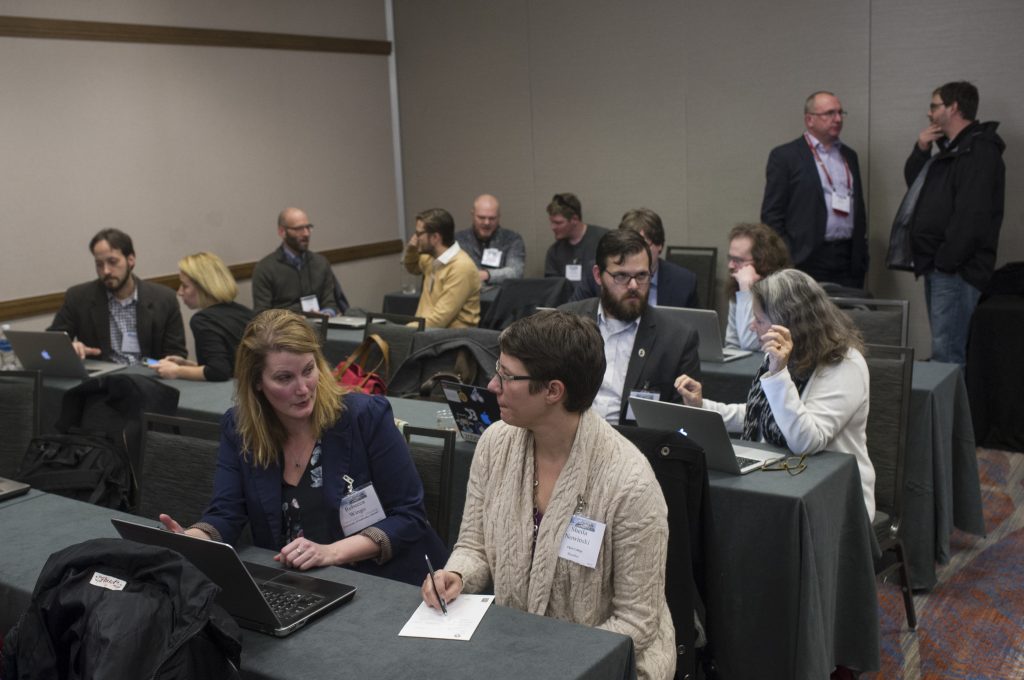On a cold January day, my history department colleagues at the State University of New York at Cortland—Randi Storch and Kevin Sheets—and I set out for the 2017 AHA annual meeting in Denver. We were on a specific mission: to learn as much as possible about digital history in three days. After looking over the program, we counted dozens of relevant panels that incorporated new and exciting digital history scholarship. Randi, Kevin, and I decided to immerse ourselves in these panels, learn as much as we can, and come back to our department with ideas for expanding our digital and public history offerings for students and colleagues.

Attendees to the annual meeting could stop by the Digital Drop-In Session to get in-person feedback on their digital projects. Marc Monaghan
To get started on our mission, each of us attended a different session in the Getting Started in Digital History Workshop on Thursday morning. I went to Jeff McClurken’s workshop on constructing a digital history syllabus and structuring a course built on digital history methods, research, and final projects. Early on, McClurken told us that digital history should make students feel “uncomfortable, but not paralyzed”—digital history courses should be challenging, but give students the tools to problem-solve in ways unique to history classes. Until noon, our group brainstormed, shared ideas, and learned some best practices and tools to incorporate into our classes. We learned about Clio, Omeka, WordPress, StoryMap JS, Century America, and dozens of other digital history tools. We also learned about the difference between a digitally inflected class and a digitally centered class, and strategized on how to get the most out of them for our students. Throughout the workshop, our students remained the center of attention. Digital history imparts skills to history students that can be translated into a host of unique job opportunities—a selling point to students (and institutions!). For example, in my Introduction to Public History class this semester, my students will contribute to an ongoing digital public history exhibit that will develop their website-building skills.
Energized by the workshop, over the next three days, we attended as many digitally focused sessions at the meeting that we could. The more we listened, the more a common theme emerged: what are the merits of collaboration for digital history? In “Collaborative Digital History” (#s110), Myron Gutmann, Jim Clifford, Ian Mulligan, Emily Merchant, and Stephen Robertson talked about their projects and the benefits of collaboration with scholars from computer science, anthropology, ecology, and other disciplines. Another perspective came from Fred Gibbs during “Making Digital History Work” (#s274), who argued that collaboration can have negative consequences, such as overreliance on others, slower work, and the loss of learning on one’s own through trial and error. Neither Gibbs nor any other presenter framed collaboration as an either/or question, but competing perspectives complicated the idea of collaboration as an implicit positive within digital history scholarship. This debate meshed with the AHA’s conference theme on historical scale—does collaborative digital history increase scale, or not? Many scholars working together can create massive archival projects like the Liberated Africans Project, which Henry Lovejoy discussed in his earlier session, but Gibbs also suggested that working in smaller scales can, over time, can produce larger scales without giving up individual freedom and creativity to build personal work.
Stories of what is possible through digital history were on display during “Emerging Scholars and Scholarship in Digital History” (#s171) and the “Digital Projects Lightning Round” (#s199). Rebecca Wingo discussed how her class used Omeka and History Harvest to organize a community history of the Rondo neighborhood in St. Paul, Minnesota. Austin Mason talked about 3D modeling to tell new stories about the medieval period. Kate Craig demonstrated how her class used Story Maps for a class project on A History of the World in 40 Objects. During the Lightning Round, the audience learned in three-minute installments about exciting projects like Karen Sieber’s “Visualizing the Red Summer,” Clayton Brown’s Masters of History online flash card game, and John Rosinbum’s #DigHist series on AHA Today. Taken together, this litany of digital history scholarship suggests a sea change: never before have historians had so many easy-to-learn options at their fingertips for incorporating digital history into their research and classes.
So, what’s next for my colleagues and me after our digital history mission to AHA17 in Denver? We want to keep the conversation going locally, on our campus. We will share what we learned with the faculty across SUNY Cortland by forming a digital humanities working group that we hope will be a forum to share pedagogical ideas, brainstorm research opportunities, and think of specific ways to incorporate digital tools into our classes for the benefit of our students. As Chad Gaffield said during the “Emerging Scholars” session, using digital history in the classroom transforms learning “from passive to active” while students learn both “content and competency” in our digital world. We want to better prepare our students for a diversity of career choices, and we feel it is necessary to impart research, analytic, writing, and computing skills in one bundle. Our history courses already stretch our students’ minds, but with digital history, we can widen their paths for the future.
This post first appeared on AHA Today.
Evan Faulkenbury is assistant professor of history at the State University of New York at Cortland. His first book will tell the story of the Voter Education Project (VEP)—a behind-the-scenes civil rights agency that funded hundreds of grassroots African American registration campaigns throughout the American South during the 1960s and 1970s. Follow him on Twitter @evanfaulkenbury.
Tags: AHA Today 2017 Annual Meeting Digital History
Comment
Please read our commenting and letters policy before submitting.






